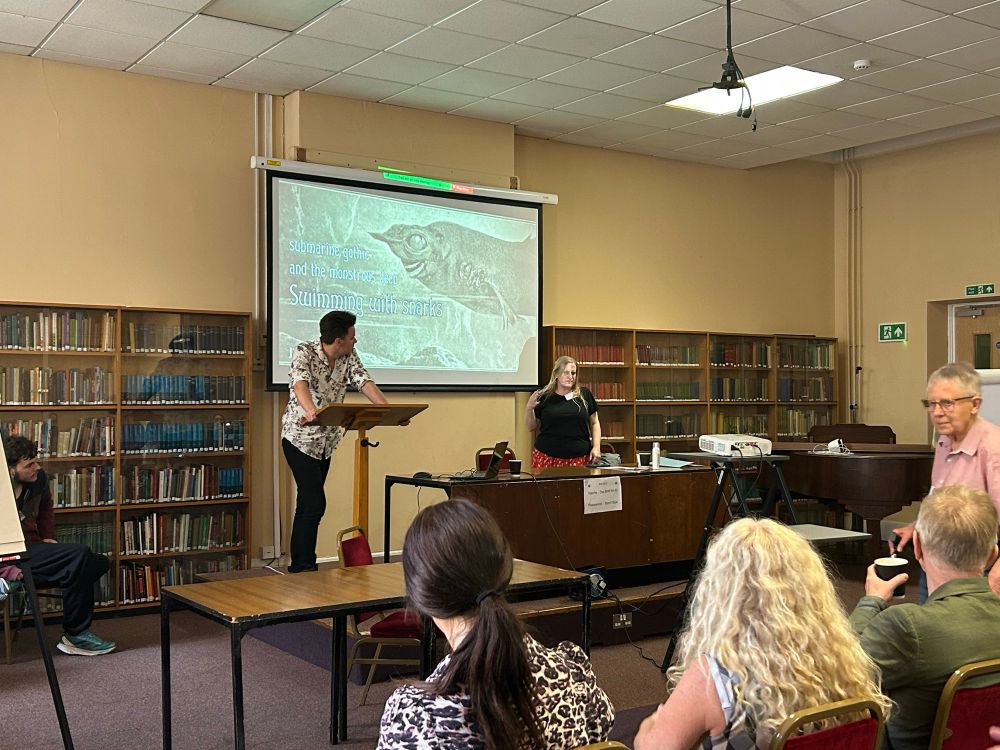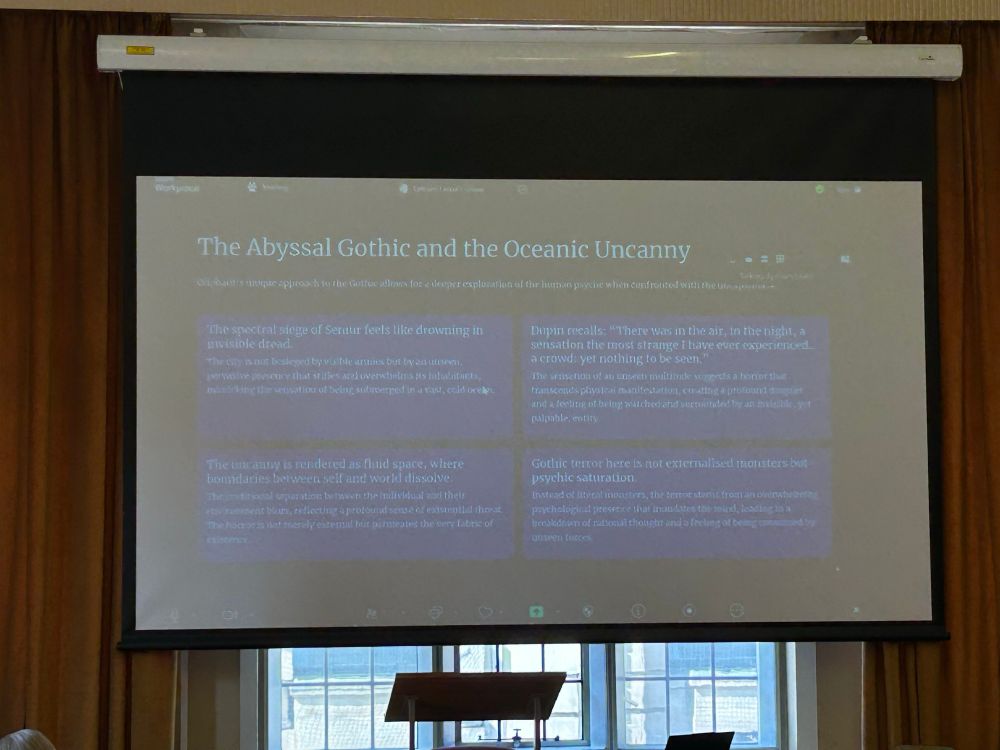



My summer holiday except I apparently exclusively take photos of Things That Are Blue
12.09.2025 10:50 — 👍 1 🔁 0 💬 0 📌 0@jamiegorrod.bsky.social
he/him • MA English Literature student




My summer holiday except I apparently exclusively take photos of Things That Are Blue
12.09.2025 10:50 — 👍 1 🔁 0 💬 0 📌 0
In relation to Heathcliff's race 'no need to be accurate... it's just a book'
Just say you are yet another bunch of cowards who don't want to deal with the histories, legacies and realities of anti-Roma racism.
www.theguardian.com/film/2025/au...

Our final paper of the Fairy Tales and Magical Creatures panel at #VPFAExtremes is Cecelia Rose, presenting 'A Fishy Tail: Edward Burne-Jones’s The Depths of the Sea (1886)'
16.07.2025 13:50 — 👍 4 🔁 2 💬 0 📌 0
On one of our final panels at #VPFAExtremes today – Fairy Tales and Magical Creatures – Silvia Storti is getting us started with '"Proof of Thought and Depth of Feeling": Gender, Power and Empire in Anne Thackeray’s Fairy Tales'
16.07.2025 13:20 — 👍 1 🔁 2 💬 0 📌 0
And our final paper of the Science and Imagination 2 panel at #VPFAExtremes today is Eva Chen, with 'The Lady Doctor and the Witch: Women Medical Missionaries in Peace with Honour and The Naulahka'
16.07.2025 09:17 — 👍 1 🔁 1 💬 0 📌 0
Our next speaker in the Science and Imagination panel at #VPFAExtremes is Bridget Morgan, with her paper 'The Rejuvenated Spinster: An Alternative Narrative of Ageing in Marie Corelli’s The Young Diana: An Experiment of the Future (1918)'
16.07.2025 08:59 — 👍 3 🔁 2 💬 0 📌 1
On one of the first panels (Science and the Imagination 2) of the final day here at #VPFAExtremes, Alphia Karaseva is talking about ‘Machines Ascendant, Humanity Submerged: Victorian Dystopian Visions of Artificial Intelligence’
16.07.2025 08:40 — 👍 1 🔁 1 💬 0 📌 0

Creatures of the deep also exceed pre-existing taxonomies as strange, hybrid forms - eerie counterparts of terrestrial creatures (some delightfully weird-looking illustrations here)
15.07.2025 14:50 — 👍 0 🔁 1 💬 0 📌 0Popular science writing offers the most sustained interrogation of the haunting, Gothic formlessness of the seafloor – the ooziness of the seabed is widely discussed, and deeply unsettling, frequently figured through negations
15.07.2025 14:50 — 👍 0 🔁 1 💬 1 📌 0Victorian popular science writers also struggle to fully articulate and imagine the affecting strangeness of the seabed. Frank Bullen writes that ‘imagination can (and does) run riot’ when thinking of the ‘silent depths where life, according to our ideas of it, is impossible’.
15.07.2025 14:50 — 👍 0 🔁 1 💬 1 📌 0Drawing on Freudian notions of the uncanny – an unsettling feeling created when we encounter what should’ve remained secret and hidden but has come to light – helps us to understand exactly what might be so unsettling about the seabed, and human encounters with it in particular
15.07.2025 14:50 — 👍 0 🔁 1 💬 1 📌 0Turning to Thomas Hardy's 'The Convergence of the Twain', the linguistic unsettlement of the benthos is clear – in revisions to the poem between 1912-14, he struggles to track the transition from seabed to surface – 'something has gone missing in the journey between worlds'
15.07.2025 14:50 — 👍 0 🔁 1 💬 1 📌 0A submarine gothic is a mode ‘of awe and wonder’, dramatising what we might think of as uncanny forms of unsettlement and drawing from a long historical tradition of these science writings alongside deep sea horror by authors such as Conan Doyle, Hugo, and Wells
15.07.2025 14:50 — 👍 0 🔁 1 💬 1 📌 0
These encounters ‘do strange things to us’ across a vast historical sweep – with Victorian science writings working alongside a Gothic imaginary to influence the later nature writings of figures such as Rachel Carson
15.07.2025 14:50 — 👍 0 🔁 1 💬 1 📌 0Encounters with the seabed, both in actuality and in imagination, confront us in ways that are, ‘sometimes wonderstruck, and sometimes horrifying and disquieting, with our own forms of epistemologies’
15.07.2025 14:50 — 👍 0 🔁 1 💬 1 📌 0Because of this inaccessibility, the benthos, Jimmy says, is realm ‘known foremost through the imagination’. This imaginative appeal owes much to the ‘apparently confounding spatialities, temporalities, and ontologies’ of the seabed, a space so far out of human reach
15.07.2025 14:50 — 👍 0 🔁 1 💬 1 📌 0Starting from the ‘relatively straightforward proposition’ that the depths of the sea are difficult to access, both literally and in terms of imagination – something that is made particularly clear in Victorian science writings of the nineteenth century
15.07.2025 14:50 — 👍 1 🔁 1 💬 1 📌 0
Our first keynote here at #VPFAExtremes is Jimmy Packham with ‘Swimming with Snarks: Submarine Gothic and the Monstrous Deep’, examining the emergence and development of what might be termed a ‘submarine gothic’
14.07.2025 11:24 — 👍 2 🔁 1 💬 1 📌 0The final encounter between father and son on a cliff edge brings not just the extremes of land, but the intense and extreme depths of the sea, into the tragedy
14.07.2025 09:44 — 👍 0 🔁 0 💬 0 📌 0The tragic destiny of the Griffiths – ‘the murder of the eighth generation Griffiths by the ninth’ – and their lives is shadowed by a dark and stormy sea, almost propelling the events to their conclusion
14.07.2025 09:44 — 👍 0 🔁 1 💬 1 📌 0The Welsh backdrop of Gaskell’s story is significant – Wales was increasingly popularised across the nineteenth century as a site of almost mythic fascination
14.07.2025 09:44 — 👍 0 🔁 1 💬 1 📌 0Gaskell loved old customs and legends, and in the particular case of her short story ‘The Doom of the Griffiths’, her attention was captured by a historical event occurring at the beginning of the fifteenth century in Wales
14.07.2025 09:44 — 👍 0 🔁 1 💬 1 📌 0The haunting ends, but no explanation is offered – ‘the dead retreat as silently as they arrive’. The Gothic becomes a philosophical exercise, and an acknowledgement of the drowned and resurfaced self and past
14.07.2025 09:42 — 👍 0 🔁 1 💬 0 📌 0
Whilst men in the novel attempt to rationalise the haunting, the women of the story attempt to understand and to listen – formulating a gendered economy of control vs care
14.07.2025 09:42 — 👍 0 🔁 1 💬 1 📌 0The character of Paul Lecamus, who accepts the haunting, plays a vital role in the reconfiguration of this haunting into a sort of sublime transfiguration – the city itself becomes a temple
14.07.2025 09:42 — 👍 0 🔁 1 💬 1 📌 0
The city is not haunted by individuals, but by a collective – shifting from personal haunting to mass haunting. The mass haunting suggests a political horror, staging the resurfacing of repressed or erased voices in spectral form
14.07.2025 09:42 — 👍 0 🔁 1 💬 1 📌 0
Oppressive silence and darkness haunts the city in this novel – characters move through fog, stifled and submerged as if drowning
14.07.2025 09:42 — 👍 0 🔁 1 💬 1 📌 0Oliphant replaces the certainty of stone with the fluidity of water, horror seeping through the cracks. The uncanny is rendered as a fluid space, where boundaries between self and world dissolve
14.07.2025 09:42 — 👍 0 🔁 1 💬 1 📌 0
Informed by theories of the uncanny, ecoGothic, and feminist Gothic, she discusses the slow submersion into psychological uncertainty traced throughout the novel
14.07.2025 09:42 — 👍 0 🔁 1 💬 1 📌 0This novel has long been read as a religious parable, but Eptisum believes that there is something deeper and more horrific to its depiction of subversion, verging into the Gothic
14.07.2025 09:42 — 👍 0 🔁 1 💬 1 📌 0